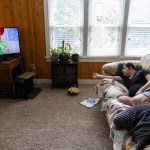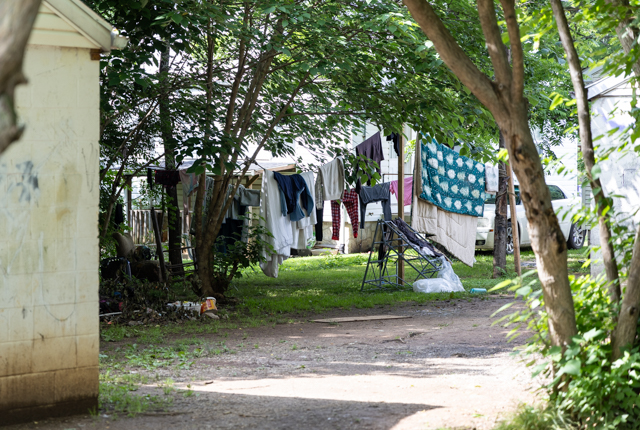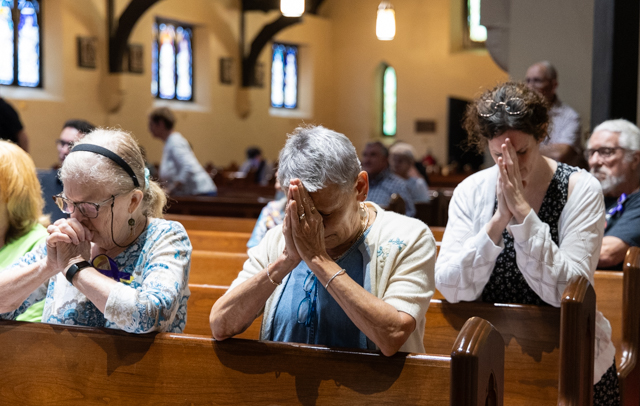As federal cuts loom, caregivers fearful of life-changing losses
Published 6:05 am Wednesday, June 18, 2025












DAVID MAMARIL HOROWITZ
david.horowitz@bgdailynews.com
Tay Orsland could never say “I love you” out loud. But as the 12-year-old reached up to touch Woody’s face, at Disney World in 2008, the moment — Orsland’s love for the man in character — was palpable. A genetic deletion disables him physically and alters comprehension. Yet, as he excitedly taps a photograph of that moment with Woody, his whoop of approval, with a trot from the kitchen, speaks for itself.
His mother and primary caregiver, Laura Orsland, toils to meet his basic needs and provide basic comforts where possible at their Bowling Green home. Every day, Laura Orsland, who has breast cancer, combs his hair, brushes his teeth, helps him shower, makes sure he uses the bathroom correctly, watches that he doesn’t fall or choke and all the other to-dos a caregiver may oversee for a loved one.
A Medicaid program, the Home and Community Based waiver, enables her to work, hire caregivers four days a week and train them to understand her son. She recalls crying on her knees after learning they had qualified.
“It meant the survival of my family, and it meant safety for my family,” she said.
Supporters of the proposed federal budget bill say it will reduce Medicaid abuse and fraud while preserving funding for the most vulnerable. But policy experts and advocacy organizations say the proposed federal cuts threaten critical resources across medically vulnerable groups — one being caregivers and those they support.
The HCB waivers are among the critical supports at risk for caregivers, according to the nonprofits Kentucky Economic Policy, Kentucky Voices for Health, the National Women’s Law Center, the Kentucky Association of Private Providers and Caring Across Generations.
Separately — and far more widely — the organizations anticipate the federally proposed additional paperwork and work requirements will cause caregivers, like numerous other vulnerable groups, to lose critical Medicaid coverage. While the bill has exemptions for work requirements across multiple vulnerable groups, including many caregivers, similar requirements elsewhere indicate a likelihood that there are those who should qualify for work exemptions who would still lose coverage.
And, advocacy organizations anticipate copays proposed by the bill to be a secondary but notable impact for many caregivers, particularly given caregiving costs.
The proposed House budget bill was already estimated to cut Medicaid spending by $793 billion and cause nearly 11 million to become uninsured by 2034, according to the Congressional Budget Office. The recently released Senate bill text maintains and in some areas doubles down on cuts and threats to Medicaid that make it more difficult for older adults, people with disabilities, and family caregivers to access and maintain health care, said Jaimie Worker, senior director of policy and research at the national nonprofit Caring Across Generations.
It’s unknown how the bill will ultimately change. But organizations watching the budget bill, including Kentucky Voices for Health and Caring Across Generations, expect work requirements and threats to HCB waivers to remain on the table.
Caregivers, meanwhile, experience impacts across intersections, said Julie Vogtman, senior director of job quality at the National Women’s Law Center: parents, especially mothers caring for their children on their own, face a disproportionately high risk of poverty and are particularly harmed by cuts to Medicaid and other programs that help them meet basic needs; caregivers who are part-time workers often have volatile schedules with unreliable hours, which can compromise work requirement hours; and immigrants — who make up 28% of the direct care workforce in long-term care services, according to the Washington University in St. Louis Institute for Public Health — would be stripped by the budget bill of multiple forms of federal assistance.
Atop it all, much research has found that the challenges caregivers experience result in increased stress and worsening physical health, Worker said. As recently as August, the Centers for Disease Control published a study that associates caregiving with a prevalence of chronic physical conditions.
The stakes, caregivers and policy experts said, are high — and in a sense, double when accounting for care recipients.
Bowling Green-based caregiver Kelly Kramer, who takes care of her mother, can attest. Medicaid covers medications for multiple chronic conditions and enables Kramer to monitor her fatty liver disease — which can otherwise worsen and lead to liver cancer.
“My health problems would likely kill me,” Kramer said about what would happen if she lost coverage.
What then came to mind, she said, was others: that if she dies, her mother and pets would get left behind.
Through the cracks
The last time Bowling Green resident Tia Tabor’s Medicaid paperwork took too long to process, she went three weeks without a diabetes injection.
Anthem had dropped out as a Medicaid provider in January, and with little choice, she switched to Humana. But the doctor’s paperwork processing for a diabetic injection took weeks.
The nerve pain debilitated her — and as the caregiver for her father, Tabor had to squeeze money from their tight budget to pay for additional caregiving.
“That’s just one example of what I’m fearful of could happen if I fall through the cracks, even if it’s for a month,” she said. “I’m very worried, because I rely on diabetic medication to stay alive, and if I am sick, I can’t take care of him … .”
The House Medicaid proposal would double enrollees’ paperwork for eligibility redetermination to once every six months and require 80 hours of monthly work or volunteering for so-called able-bodied adults between 19 and 64 without qualifying conditions such as having a dependent; the Senate proposal would add the work requirements for parents of children older than 14. For the work requirement, it’s unknown how exactly the paperwork for proving work or obtaining an exemption would look.
But what is known, and what nearly all interviewees stressed, is that paperwork is already extensive — and more means additional chances for people to lose coverage.
Caregivers, per the House bill, are supposed to be exempt from work requirements. But Emily Beauregard, executive director of Kentucky Voices for Health, as well as other advocates and analysts anticipate most will have to prove it — which is where enrollees who should be eligible are anticipated to fall through the cracks.
Almost a quarter of those in Arkansas subject to Medicaid work requirements in 2018 lost coverage within seven months, according to the Center on Budget and Policy Priorities — before a federal judge halted it due to coverage losses and a violation of Medicaid’s purpose; another federal judge stopped an attempt to impose work requirements in New Hampshire when it was found two-thirds of enrollees targeted by the 2019 policy would have lost coverage, according to the New Hampshire Fiscal Policy Institute.
And in Georgia, the experiment for a Medicaid work requirement — which has cost more than $50 million in software and administration — had a backlog of over 16,000 applications 14 months following its launch, according to the Associated Press, which cited a renewal application.
“It’s unclear what it would take” to acquire an exemption, Beauregard said. “Not every disability, or not every type of exemption, has an official document that you can provide for it.”
Caregivers’ busyness leaves them especially vulnerable to losing coverage due to paperwork requirements, the organizations and caregivers said.
“We caregivers have two bodies to care for,” said Laura Orsland, the primary caregiver for her son. “Two mouths to feed literally, four ears to clean out, twice as many trips to the bathroom as a normal person, at least.”
And completed paperwork isn’t a guarantee there won’t be lapses in services.
Laura Orsland and her son have experienced it themselves: When Tay Orsland was 12, the state added paperwork to stay on a waiting list for a separate, long-term waiver that would provide around-the-clock care. Despite several attempts to submit the paperwork in a timely manner, they were rejected — which has cost them five years on the waitlist.
As the executive director of The HIVE — a Bowling Green nonprofit serving those with intellectual and developmental disabilities — Laura Orsland added that she’s seen many lose opportunities for life-changing support due to paperwork submission requirements and processing.
Alvaton resident Mary Beth Patton is another who takes care of her severely disabled adult child — who has been kicked off of Medicaid three times due to workers checking one incorrect box, Patton said.
“People who are already dedicating a significant amount of time and energy toward providing intensive care (would now) navigate additional paperwork and reporting requirements in order to maintain either their healthcare or the supports and services that allow them to provide care for their family members at home,” summed up Worker, from Caring Across Generations.
Waivers, and cuts
Patton recalls the time she encouraged her nonverbal, 3-year-old daughter, who will go by her initial A., to request additional pushes on a swing — teaching A. sign language for her first word: “more.” A. — who lives with epilepsy, cerebral palsy, and brain damage — cannot walk and requires assistance to meet basic needs such as eating. Still, assisted by a paraprofessional, the 18-year-old crossed the graduation line last month to receive her alternate diploma from Warren County Public Schools.
“We did it,” Patton recalled herself thinking. “By God: We did it. … Against all odds, she did it.”
Numerous therapies and services supported them along that way — and, as with Laura Orsland, a Home and Community Based waiver has become critical. Each type of HCB waiver requires meeting a specific regulatory qualification and definition, primarily based on their disability or diagnosis — and they largely waive the Medicaid income cap while providing supports, said Amy Staed, CEO of the Kentucky Association of Private Providers.
For many with intellectual and developmental disabilities as well as physical disabilities, these waiver services are vital, said Orsland, the mother who has used an HCB waiver to support her adult son.
More than 13,000 in Kentucky wait for HCB waivers, Beauregard said. They’re at threat, according to the organizations interviewed, because federal cuts to programs are expected to leave more financial burden on states — squeezing out state funding for programs, particularly those that, instead of being mandatory, are optional.
These waivers are optional.
“It is certainly a valid concern for caregivers that the cost shifts in this bill would threaten continued expansion of those services,” said Dustin Pugel, policy director at Kentucky Economic Policy.
For example, the federal budget shifts some SNAP costs to states — and an increased state commitment to SNAP would crowd out other investments, Pugel said.
“Anything optional goes on the chopping block,” he said, summing up others’ concerns for the waivers.
The Senate’s additional proposed cuts to provider taxes exacerbate these concerns, said Staed, from the Kentucky Association of Private Providers. These taxes draw a federal match in funding, and states rely upon them to finance their Medicaid programs; while the House proposal wouldn’t allow states to raise these taxes, the Senate bill begins to phase them out, Staed said.
This also intersects with state legislation: Because the Kentucky legislature is aiming to bring the income tax to zero, less and less revenue is becoming available to provide basic supports and programs statewide, Beauregard said.
“And if more cost is shifted to our state budget, there just simply won’t be enough revenue to cover it all,” she concluded.
Patton’s waiver, similar to Orsland’s, allows her to hire employees and acquire home health services. It provides at least some peace of mind, Patton said, as it ensures her child can be properly cared for.
“Without those services, either our kids are going to go without care (…), or parents have to quit their jobs … It’s an overwhelming hopelessness,” she said of the potential to lose funding for HCB waiver supports. “You love your child so much and you would do anything, and we do: We already fight enough to keep the boxes checked, to keep the appointments lined up, to keep the medicines given, to keep the therapies going, to keep the teachers informed, to keep (others) informed, to keep the proper foods.
And then they’re looking at us, saying, ‘Well, it’s optional.’”
Copays, caregiving expenses
Any copays instituted would intersect with the financial costs and ramifications of caregiving, according to Beauregard.
Part of it is the difficulty family caregivers experience finding flexible, decent-paying work while juggling caregiving responsibilities. Another aspect is expenses — with the AARP estimating that informal caregivers average spending about 26% of income on caregiving.
Meanwhile, some 54,000 adults under age 65 covered by Medicaid, about 87% of them women, didn’t work due to taking care of their “family (or) home” on average annually from 2022-24 statewide, according to Current Population Survey data.
The House-proposed bill would require states to impose co-pays of up to $35 per services for single adults in one-person households up to age 64 making $15,650 to $21,597 — the Medicaid cap — with some exceptions such as for primary care, mental health and substance use disorder services, per the national nonprofit Kaiser Family Foundation.
“When you have a copay that’s required, and somebody is (…) really low income — we’re talking about people making $16,000, $17,000, $18,000 a year — to require that they are able to pay a copay in order to get care, it will mean that they either delay getting care or they ration the care that they get,” Beauregard said.
Kramer, who takes care of her mother, can attest.
She makes $12 an hour at a gas station, where her hours will vary.
“A $35 copay would add an additional financial burden that would limit my ability to make my visits,” she stated. “Especially if it’s something urgent. I don’t always have money to spare. I rarely have money that doesn’t go towards paying off debt.”
Horowitz reports for the Daily News via a partnership with Report for America.


















